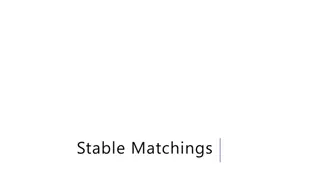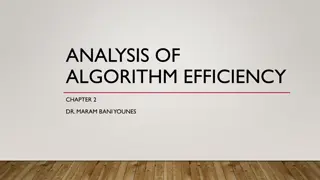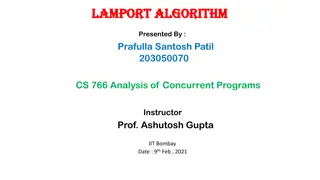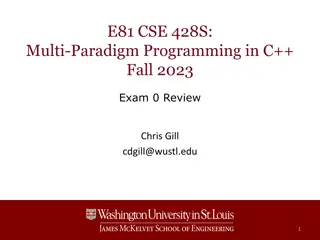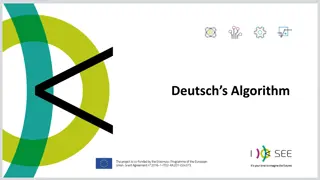Algorithm Design and Design Decisions Review for Computer Science Exam II
This review covers topics such as efficient algorithm design for shortest path problems using reductions and designing data structures for managing tasks and flashcards in computer science. It includes explanations of how to improve on Dijkstra's algorithm and the use of data structures like stacks and dictionaries for specific tasks.
Download Presentation

Please find below an Image/Link to download the presentation.
The content on the website is provided AS IS for your information and personal use only. It may not be sold, licensed, or shared on other websites without obtaining consent from the author.If you encounter any issues during the download, it is possible that the publisher has removed the file from their server.
You are allowed to download the files provided on this website for personal or commercial use, subject to the condition that they are used lawfully. All files are the property of their respective owners.
The content on the website is provided AS IS for your information and personal use only. It may not be sold, licensed, or shared on other websites without obtaining consent from the author.
E N D
Presentation Transcript
CSE 373 Section 9 Exam II Review
Reduction: Shortest Paths Design an efficient algorithm for the following problem: Given a weighted, directed graph G where the weights of every edge in G are all integers between 1 and 10, and a starting vertex s in G, find the distance from s to every other vertex in the graph (where the distance between two vertices is defined as the weight of the shortest path connecting them, or infinity if no such path exists). Your algorithm must run faster (asymptotically) than Dijkstra's. You must show the running time of your algorithm in terms of V and E (the number of vertices and edges in the original graph).
Reduction: Shortest Paths Observation: Dijkstra and BFS process nodes in the same order if all edge weights are identical. Solution: For every edge e in the graph, replace e with a chain of w-1 vertices (where w is the weight of e) where the two ends of the chain are the endpoints of e. Pictorially: 3 1 1 1 A B A B Then run BFS on the modified graph, and update the dist and pred fields just like in Dijkstra. This works because we still visit the nodes in the same order, without the need for a PQ!
Reduction: Shortest Paths Runtime: The new graph has at most 10 edges for every edge in the original graph, and at most |V| + 9|E| vertices. So BFS runs in (|V| + 9|E| + 10|E|) = (|V| + |E|) time. Faster (asymptotically) than Dijkstra! ...since Dijkstra is (|V| + |E|)logV due to the need for a PQ.
Design Decisions: B i Q: You are writing a program to manage a todo list with a very specific approach to tasks. This program will order tasks for someone to tackle so that the most recent task is addressed first. How would you store the transactions in appropriate order? Main idea: Most recent task should be handled first, also known as L.I.F.O: Last in, first out A: Stack -> Our go-to LIFO data structure!
Design Decisions: B ii Q: You are writing a study support program that creates flash cards where each flash card has two pieces of crucial information: the question to be asked and the correct answer. How would you store these flash card objects? Main idea: Questions have an associated correct answer A: Dictionary (or map) -> We can use the question to look up the answer!
Design Decisions: B iii Q: You are writing a program to store the history of transactions for a small business. You need to maintain the order in which the transactions occurred and be able to access entries based on the order in which they were received Main idea: Keep the relative order, and be able to access elements A: List -> We can get elements without manipulating the data!
Design Decisions: B iv Q: You are writing a program to surface candidates for a job. As candidates are met and evaluated, they are added to a collection from which hiring managers can request the next best applicant whenever they have an open job position. How would you store the candidates and their evaluations for hiring managers to be able to quickly get the next best applicant? Main idea: Quickly access the best candidate A: Heap -> Priority = goodness of the candidate. We can return the best applicant quickly!
Design Decisions: B v Q: You are writing a program to schedule jobs sent to a laser printer. The laser printer should process these jobs in the order in which the requests were received. How would you store the jobs in appropriate order? Main idea: Process jobs in order received. Also known as... F.I.F.O: First in, first out A: Queue-> Our goto FIFO data structure
Design Decisions: B vi Q: You are developing a video game where you play as the Roman Empire. Every time you conquer a city-state, that city-state and everything they own is added to your empire. Main idea: Easily add everything from a city-state to belong under us. A: Disjoint Sets -> Each city-state and the Roman Empire are sets. Whenever a city-state is taken over, add it to the Roman Empire set!
Sorting Design Decisions: a Q: Suppose we want to sort an array containing 50 strings. Which of the following five algorithms is the best choice? insertion sort, merge sort, quick sort, selection sort, heap sort Main idea: - Only 50 strings - When it comes to computer programs, this is not a very large input size A: Insertion Sort - Fast on small inputs - May be worst-case (n^2) but it also has a low constant factor - Merge, quick, and heap sort may also be reasonable choices!
Sorting Design Decisions: b Q: Suppose we have an array containing a few hundred elements that is almost entirely sorted, apart from one or two elements that were swapped with the previous item in the list. Which of the following algorithms is the best way of sorting this data? insertion sort, merge sort, quick sort, selection sort, heap sort Main idea: - Array is already almost entirely sorted - Only have to move a few elements, and swap them with their neighbor A: Insertion Sort - Runs in (n) time for inputs that are already or close to completely sorted
Sorting Design Decisions: c Q: Suppose we want to sort an array of ints, but also want to minimize the amount of extra memory we want to use as much as possible. Which of the following algorithms is the best choice? insertion sort, merge sort, quick sort, selection sort, heap sort Main idea: - Minimize memory!! A: Quick Sort - In place so it uses no extra memory
Sorting Design Decisions: d Q: Suppose we have a version of quick sort which selects pivots randomly to create partitions. Explain how you would build an input array that would cause this version of quick sort to always run in O(n^2) time. What would the array look like? What happens when you try running quick sort on it? Main idea: - To get good performance time with quick sort, we partition the input array into roughly halves each time. For bad, O(n^2) performance we would need to do the opposite. A: Array with all duplicate elements - Each time you partition, all elements will fall on the left side of the partition, since they are <= to. We will always get O(n^2)
Sorting Design Decisions: e Q: How can you modify both versions from quicksort so that they no longer display O(n^2) behavior given the same inputs? Main idea: - An array with all duplicate elements will always be sorted in O(n^2) time because the elements will always fall on the left of the pivot A: Partition the array into three groups instead of two. Have the middle group represent duplicates and do not perform further quicksort on this group. - There would be no more work left to do for the duplicate group - Our modified algorithm would sort an all duplicate array in O(n) time instead of O(n^2)!
Graph Design Decisions: a Some files depend on others. We need to figure out the order of files which need to be compiled!
Graph Design Decisions: a Let vertex be the file File F File C File B
Graph Design Decisions: a Edges are directed because we have a set of order we need to follow File F File C File B
Graph Design Decisions: a Is it weighted or unweighted? File F File C File B
Graph Design Decisions: a Unweighted We need to identify the orders but not other constraints that needed to be represented as a weight on the edge File F File C File B
Graph Design Decisions: a Is there an algorithm that we can use to identify the order that the file needs to be compiled? File F File C File B
Graph Design Decisions: a BFS: when you want to find the shortest path DFS: when you want to exhaust all possibilities Dijkstra's algorithm: Finding shortest Path Topological Sort: some objects that are ordered based on some rules. File F File C File B
Graph Design Decisions: a BFS: when you want to find the shortest path DFS: when you want to exhaust all possibilities Dijkstra's algorithm: Finding shortest Path Topological Sort: some objects that are ordered based on some rules. File F File C File B
Graph Design Decisions: a Given an undirected and connected graph could be represented as G = [(B, C), (C, F)] File F File C File B
Graph Design Decisions: a G = [(B, C), (C, F)] File B File C File B How do we know which is the first file to compile without iterating through the adjacency list? File F File C
Graph Design Decisions: a Input: G = [(B, C), (C, F)] File B File C File B B C F 0 1 1 File F File C
Graph Design Decisions: a Input: G = [(B, C), (C, F)] File B File C File B B C F 0 1 1 File F File C
Graph Design Decisions: a Input: G = [(B, C), (C, F)] File B Now we can simply enqueue B and decrement the count of course who needs to compile B first! File C File B B C F 0 1 1 File F File C
Graph Design Decisions: a Input: G = [(B, C), (C, F)] File B Now we can simply enqueue B and decrement the count of course who needs to compile B first! File C B C F 0 0 1 File F File C
Graph Design Decisions: a Input: G = [(B, C), (C, F)] File B Now we can enqueue file C as it does not have any more file to pre-compile and decrement the file F which needs to compile file C before itself. File C B C F 0 0 0 File F
Graph Design Decisions: a Final Queue! File F File C File B
Graph Design Decisions: a Algorithm
Graph Design Decisions: a Runtime
Graph Design Decisions:b We need to remember who follow who
Graph Design Decisions:b USER A USER C Directed Edge representing followers USER B
Graph Design Decisions:b LV 1 USER A Directed Edge representing followers USER C USER B
Graph Design Decisions:b LV 1 USER A USER C We can use an algorithm that are utilize neighbors! EX) BFS, DFS USER B
Graph Modeling: a Q: Frodo and Sam are on their way to Mordor to destroy the ring, and along their path they have to pass through several human villages, some of which are now deserted and likely Orc territory. They learn that some paths are being heavily guarded by Orcs, and they want to avoid those paths at all costs. Friendly spies tell Frodo and Sam that they should avoid the road between two deserted villages, as it is more likely to be monitored by Orcs. Thinking ahead: Frodo and Sam will need to find the shortest and safest path to Mordor (in part b). How would you represent a graph to capture this problem? - Vertices? - Directed? - Self-loops? - Edges? - Weighted? - Parallel edges? Our graph model needs to support that!
Graph Modeling: a How would you represent a graph to capture this problem? Break down situation into key information: 1) Traveling to Mordor. Need to pass through villages. 3) Certain roads to villages could be monitored by dangerous Orcs. 2) Villages could be occupied or deserted. 4) Avoid roads between two deserted villages. Likely to have Orcs. Vertices can be villages, edges can be roads between villages. Vertices can store information about whether that village is occupied or deserted. Undirected. Frodo and Sam should be able to walk on a road in either direction. Unweighted. No additional information needed on edges. Allow parallel edges since there may be different roads connecting two villages. No self-loops since they aren t useful in any way here.
Graph Modeling: b Q: How should Frodo and Sam find the shortest and safest path to Mordor? State the runtime of your solution. Graph Model Shortest path algorithms? Vertices: villages and occupation status. BFS and Dijkstra s! We don t have edge weights here so BFS will work just fine. Let s pick it over Dijkstra s because it s more efficient. Edges: roads between villages. Undirected, unweighted. Parallel edges, no self-loops. Safest path algorithms? What does safe mean in the context of our graph? Uhhh . Remember that friendly spies told Frodo and Sam to avoid roads between two deserted villages, since they re likely to be monitored by Orcs!






